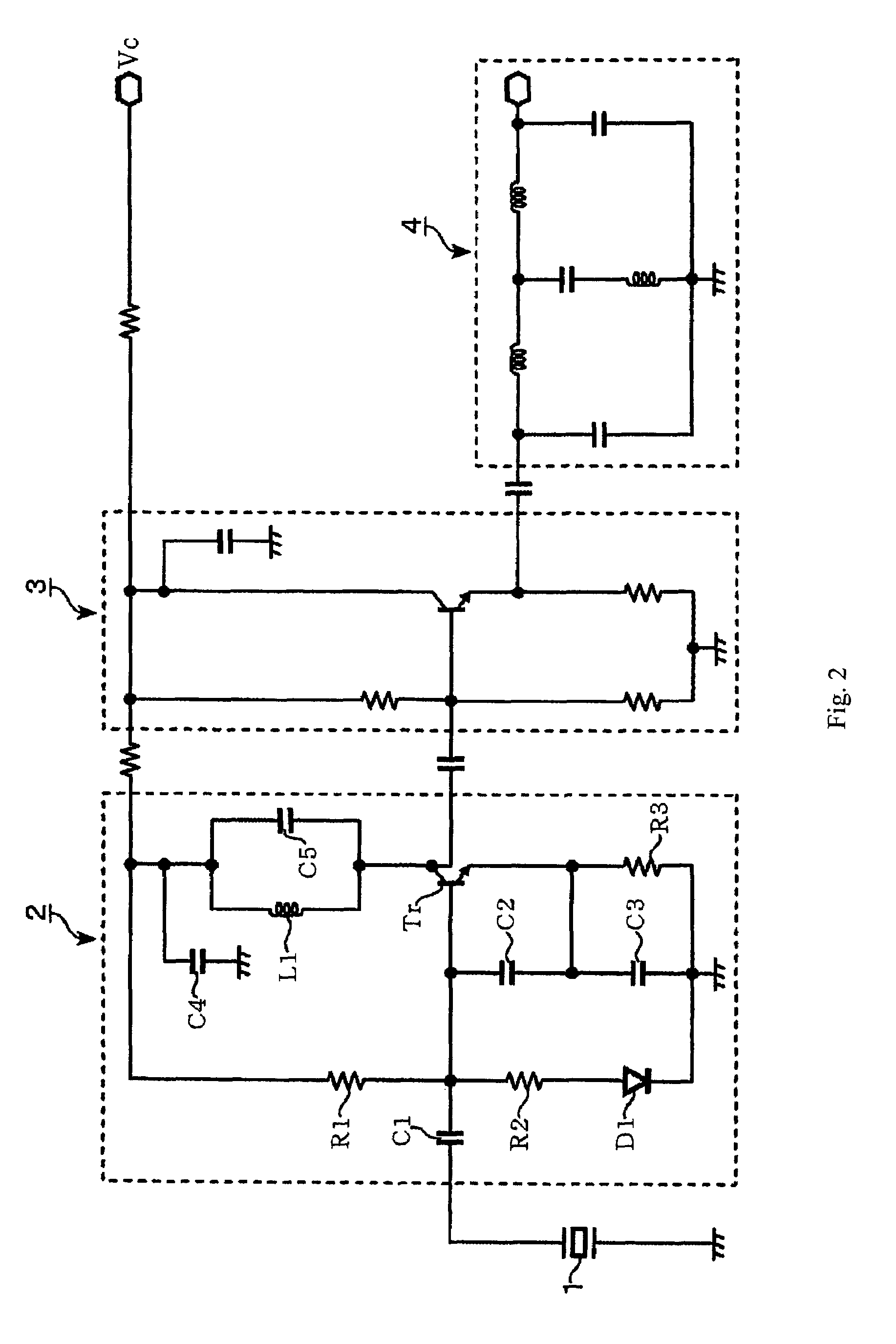Sensing device
a technology of sensing device and amplitude signal, which is applied in the direction of vibration measurement in solids, analysis of fluids using sonic/ultrasonic/infrasonic waves, instruments, etc. it can solve the problems of inconvenient use, unstable frequency, and considerable amplitude level of frequency signal when using in liquids, so as to achieve stable oscillation, reduce size, and high negative resistance
- Summary
- Abstract
- Description
- Claims
- Application Information
AI Technical Summary
Benefits of technology
Problems solved by technology
Method used
Image
Examples
embodiment 1
[0051]FIG. 1 is a block diagram of a sensing device showing an embodiment of the present invention. The difference from FIG. 11 is the structure omitting an amplitude control circuit 6 and a second buffer amplifier 5. FIG. 2 is a circuit diagram showing the structures of respective blocks in FIG. 1 in detail.
[0052]Firstly, in the present embodiment, the sensing device having an oscillation frequency of 30.8 MHz is assumed. In this oscillation frequency, the impedance of a tuning circuit connected to the output unit of an oscillation amplifier element of a Colpitts oscillation circuit 2 is set at a value having inductivity in the oscillation frequency. In more specific, a tuning circuit 20 composed of a parallel circuit of an inductor L1 and a capacitor C5 is provided between a collector of a transistor Tr (BJT-NPN) and a supply source Vc. The inductor L1 and the capacitor C5 are set at 4.7 uH and 3 pF respectively, so that they are composed as a tuning circuit exhibiting inductivity...
embodiment 2
[0055]Although the peak of the negative resistance in FIG. 3 is about 400 Ω, a method of increasing the negative resistance will be explained hereinafter giving an example. In the present embodiment, by limiting the capacity ratio of a pair of capacitors C2 and C3 for capacity division, and the impedance at the oscillation frequency in a Colpitts oscillation circuit in which the tuning circuit 20 in Embodiment 1 is made inductive, improvement of the negative resistance is attempted. In specific, the respective capacity of the capacitor C2 connected between a base and an emitter of the transistor Tr as an amplifying element for oscillation, and the capacitor C3 connected between the emitter and a ground (GND) are determined as follows. The ratio of the impedance at the oscillation frequency of the capacitor C2 to the impedance at the oscillation frequency, for instance, 30.8 MHz of the capacitor C3 is set at 3 or more. In other words, the ratio of the capacity of the capacitor C2 to ...
embodiment 3
[0063]In the present embodiment, by making the tuning circuit inductive as in Embodiment 1, and by setting the bias resistance connected between the collector and the base of an amplifying element for oscillation to be 3 kΩ or less in a Colpitts oscillation circuit in which the capacitance ratio of the capacitors C2 and C3 and the impedance of the capacitor C2 are limited as in Embodiment 2, reduction of the negative resistance is prevented. For instance, the bias resistance R1 in FIG. 2 is set to 1.2 kΩ.
[0064]FIG. 9 shows a negative resistance characteristic when the bias resistance R1 is varied. As the test conditions at this time, the capacitor C2 has an impedance of 300 Ω at the oscillation frequency, and C2 / C3=⅓.
[0065]In the figure, the characteristic A is the case of R1=2 kΩ, the characteristic B is R1=3 kΩ, and the characteristic C is R1=4 kΩ. In order to obtain a negative characteristic of 1 kΩ or more at the oscillation frequency from the characteristic, the characteristic ...
PUM
| Property | Measurement | Unit |
|---|---|---|
| impedance | aaaaa | aaaaa |
| bias resistance | aaaaa | aaaaa |
| oscillation frequency | aaaaa | aaaaa |
Abstract
Description
Claims
Application Information
 Login to View More
Login to View More - R&D
- Intellectual Property
- Life Sciences
- Materials
- Tech Scout
- Unparalleled Data Quality
- Higher Quality Content
- 60% Fewer Hallucinations
Browse by: Latest US Patents, China's latest patents, Technical Efficacy Thesaurus, Application Domain, Technology Topic, Popular Technical Reports.
© 2025 PatSnap. All rights reserved.Legal|Privacy policy|Modern Slavery Act Transparency Statement|Sitemap|About US| Contact US: help@patsnap.com



